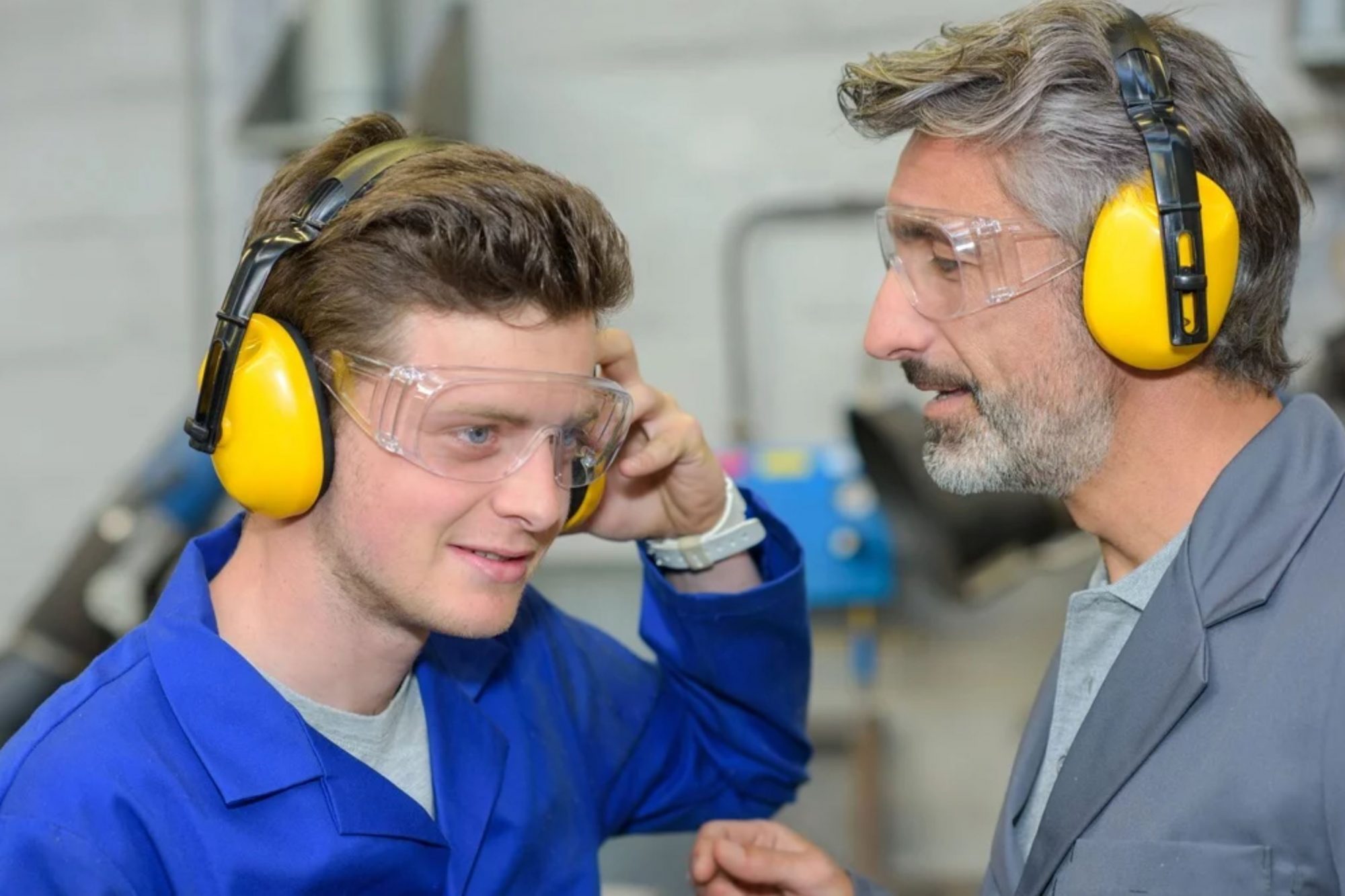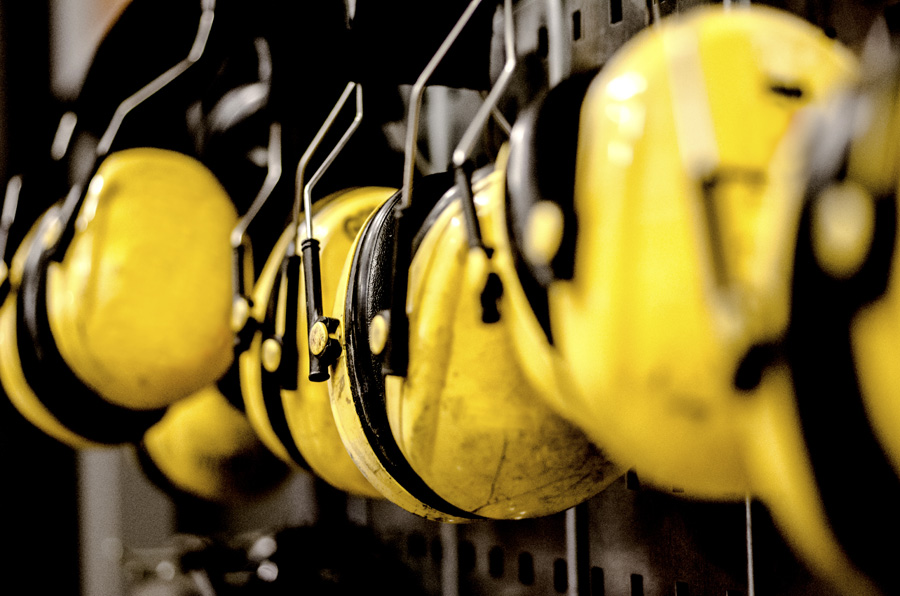Hands-Free Construction Headsets Improve Crew Communication
BY AsphaltPro Staff

In the September 2019 issue of AsphaltPro, John Ball wrote about how the team at The Earle Companies, Farmingdale, New Jersey, uses 3M™ PELTOR™ PowerCom Plus headsets to cut through the noise on the job.
“It’s not only a safety measure; it also helps with training and workflow,” Ball said. “When I worked onsite with them for training purposes, I could communicate with workers who were on equipment out of shouting distance. That’s the kind of immediate communication your training supervisors and paving foremen often need out on the jobsite.”
The headsets make it possible for the team to communicate with one another, while blocking out damaging noise without blocking important sounds.
“It used to be that a new guy on the job could only learn visually by watching others on the crew,” said Alex Kundrat, president at Speak Easy Communications, Cleveland, Ohio. “Now, he can hear the senior guys talking and pick things up much faster, and the crew can explain things as they go.”
Kundrat first experienced the use of headsets to improve communication while working in the tree care industry. “I knew headsets would make our work more efficient, but one thing I never anticipated would be how much it minimized my anxiety on the job,” Kundrat said. “You don’t realize how exhausting it is to communicate in such loud environments.”
AsphaltPro spoke to experts in the field to find out what features are key for wireless intercom headsets in the construction trades.
Must-Have Features for Construction Headsets
“All systems have their strengths and weaknesses,” Kundrat said. What’s important is to identify features that are important for your operations and thoroughly research the options available. Here are a handful of key features.
1) Ambient noise features
One of Kundrat’s top features to look for is what Speak Easy calls noise filtering, though names for this technology differ. The general idea is that the system is able to, for example, reduce the noise of the milling machine to perhaps 10 percent of its total volume while voices are transmitted at normal volume.
“Any headset made for this type of work will have noise filtering features,” Kundrat said, adding that headsets for other uses–such as motorcycling–may not have the features needed for the construction industry.
According to Jim Kruckow at Sensear, Carpentersville, Illinois, its headsets offer a feature called 360 situational awareness.
“This allows you to hear everything around you directionally,” Kruckow said, “so if there is a backup alarm going off behind you, you will know what direction that noise is coming from even within the headset.”
Another feature Kruckow recommends is face-to-face communication, where people can speak to each other directly, speech is enhanced and passed through the headset so you don’t miss a word.
He also suggests ensuring the model you choose can handle intermittent noise. like machinery revving up or impact hammers. “Some headsets will clip those noises, which means it’ll cut out when that loud noise hits,” he said.
2) Noise Reduction Rating
“It’s important both to protect workers’ hearing and keep communication open for safety and productivity,” Kruckow said. “That’s why our headsets offer a noise reduction rating between 23 dB and 31 dB, depending on the model.”
The Speak Easy intercoms are attached to the crew’s existing noise-reducing earmuffs, so the intercom itself has no NRR capabilities for ambient noise. However, Kundrat said, engine noise is filtered before it is transmitted.
Wireless Communication Solutions for Construction | Sonetics
3) Connectivity Options
One feature Kruckow said sets Sensear headsets apart is the range of communication options built in. Its headsets can be wired to a two-way radio, operate over Bluetooth, or headset-to-headset short-range.
“Having multiple forms of communication ensures you’re not stuck with one type of communication,” Kruckow said. “If you only have headset-to-headset, and you later start using two-way radios for something, you’d have to buy all new headsets.”
With built-in short-range, Sensear has no limit to the number of headsets on the same channel. Its headset range is anywhere from 50 to 150 feet, depending on the environment.
Some operations may find it useful to have multiple channels, so some members of the crew can talk on one channel and switch to the other channel if need be.
Speak Easy headsets connect via bluetooth or two-way, and will soon be compatible with CB radios. “One person will be able to link their headset to a handheld CB on their belt so they can talk to truck drivers by pressing the inline mic key,” Kundrat said. “You can have the trucker’s responses feed into the other guys, or turn that off if they don’t need to hear it.”
Although some headsets offer the ability to connect to smartphones via Bluetooth to take calls or play music, Speak Easy deliberately chose not to incorporate this feature in an effort to encourage the crew to avoid distractions.

4) Operating Range
Every headset will offer a different operating range, so Kundrat recommends thinking about your operation and the typical distance between employees. For example, Speak Easy can pair six headsets operating within 300 feet of one another. In flat environments without many obstructions, or if the six headsets are spread out, that can extend up to 900 feet.
5) Operating Method
Each headset offers different operating modes. For example, push-to-talk requires the user to push a button while talking. Voice activation, or VOX, is just what it sounds like. It activates when someone begins speaking, though the first couple of words may be cut off, so Kruckow suggests starting each transmission with a keyword so no one misses out on crucial information (they’ll instead miss the keyword if VOX doesn’t pick up the first couple of seconds). Sensear’s headsets operate either with push-to-talk or VOX based on your two-way radios’ capabilities.
A third option includes live continuous mic, where everyone is heard at all times. This is the method Speak Easy relies on, with the ability for a user to mute their own microphone if they need a bit of privacy.
6) Transmission Modes
Beyond operating modes, you should pay attention to transmission modes.
Speak Easy’s headsets are full-duplex, meaning they allow for simultaneous communication in all directions. Kundrat prefers this communication method so, in the event of an urgent warning, that message will be immediately communicated to the whole crew without having to wait for the channel to clear.
Sensear’s headsets are half-duplex, meaning only one person can talk at a time. However, if used to take a call, the user can opt to switch the headset to full duplex to take the call while also maintaining situational awareness of the job site.
7) Ergonomics
“Ergonomics are definitely important,” Kruckow said. “If it isn’t comfortable, no one is going to wear it all day. And if you take off the headset, you’re taking away your hearing protection.”
Most headset manufacturers offer a variety of models to suit user preferences and various work environments. Kruckow adds that people working in hot environments often opt for Sensear’s earplug-style model. Cold-environment workers tend to prefer the full headset. Sensear also offers dual protection headsets using both styles together, while still maintaining situational awareness and face-to-face communication in extreme loud environments
Sensear’s headsets can be used to accept calls. “Some calls may be necessary for the job,” Kruckow said. “And we don’t want anyone taking off the headsets for any reason throughout the shift.”
Sensear’s headsets are also compatible with hearing aids. “There are a lot of people who have experienced hearing loss and rely on hearing aids,” Kruckow said. “A lot of headsets will create feedback, but ours do not.”
Speak Easy offers two models: one that integrates into any earmuff and mounts to a hardhat and a second model that is a more rugged version of the type of headset call center workers might wear. The headsets also offer a volume boost option for people who need to turn up the volume to combat existing hearing loss or those who wish to wear earplugs beneath the headset.
In addition to the handful of options already mentioned, other manufacturers include Earmark, Firecom, Sena and Sonetics, among others.
Construction Headset Implementation Tips
Kundrat recommends setting aside 20 or 30 minutes on the first day using the intercoms, or even giving crews a chance to try them out at the shop before heading to the job. “This gives them a chance to get used to the features in a controlled environment instead of trying to figure it out in the middle of a job and getting frustrated.”
He also recommends having the foreman collect the headsets at the end of the shift for charging overnight and passing them back out the following day.
“You don’t want to have one break in the chain if one guy forgets his headset one day,” Kundrat said. Most headsets will last a whole shift–often two full shifts–but Kundrat adds it’s also possible to charge Speak Easy headsets on the go, with either a portable battery pack or via an automobile auxiliary power outlet. Models from some manufacturers, such as Earmark, offer the option of powering the headsets with either a rechargeable battery or two 9-volt alkaline batteries.
Kundrat also cautions against over-reliance on the headsets, and urges headset wearers to use common sense. “Just because someone says in the headset, ‘I’m backing up,’ doesn’t mean they should be any less careful than they would without the headset,” he said. “What if one guy’s headset broke or died? The person backing up still needs to wait to hear ‘All clear’ from the people around them. We can’t get too comfortable with technology.”

